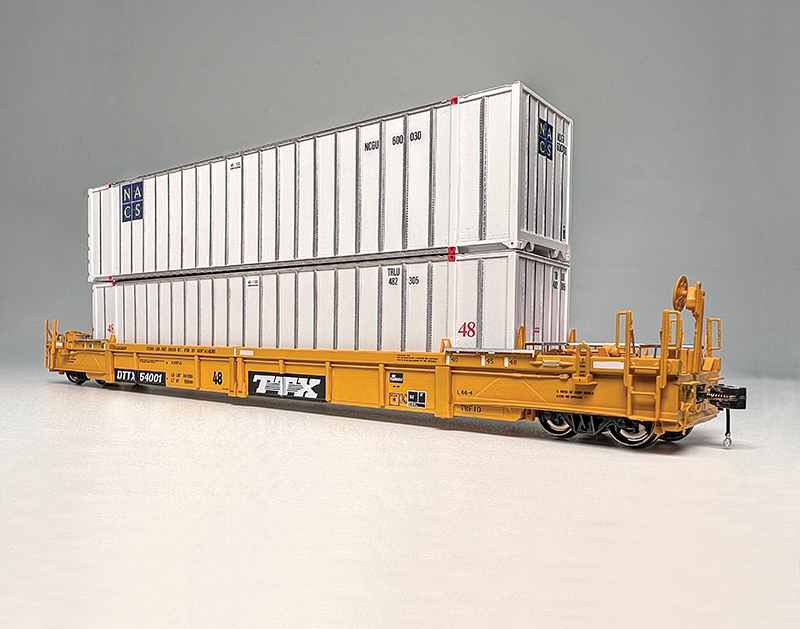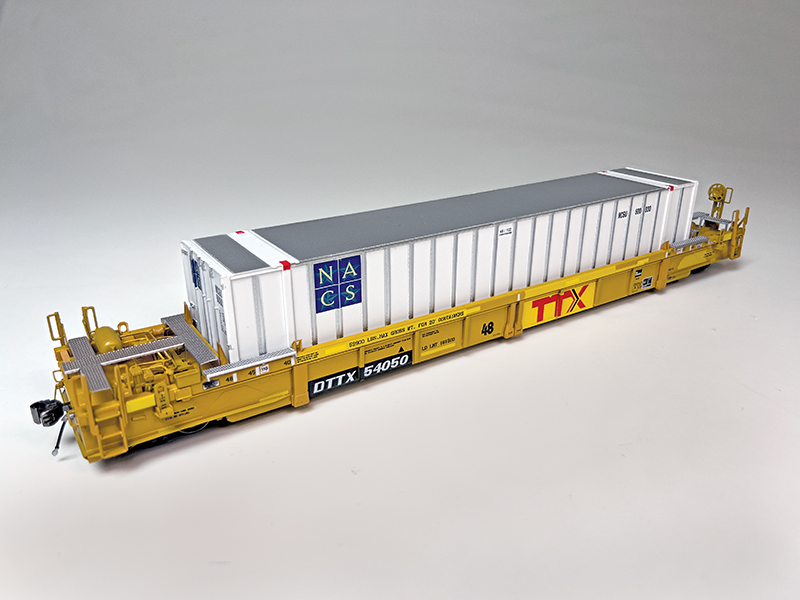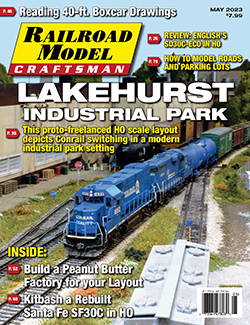 Review by Harry K. Wong/photos by the author
Review by Harry K. Wong/photos by the author
The concept of railcars carrying shipping containers in a double-stacked configuration is familiar to most rail enthusiasts. After years of carrying containers on flatcars (COFC), Southern Pacific worked with ACF Industries to develop a “well car” capable of carrying two intermodal shipping containers stacked on top of each other. This concept proved highly successful as it allowed for the transport of many more containers on a train of a given length rather than using conventional single-level 89’ flatcars. The economies of scale continued to evolve as container sizes steadily increased, culminating for a period in the introduction of 48-ft. by 102-in. wide domestic shipping containers by American President Lines (APL) in 1985.
Larger and heavier containers demanded new stack car designs. One of the first cars to address this need was Thrall Car’s TWF10 double-stack well car. With its smooth sides punctuated by vertical stiffeners, the TWF10 shared many similarities with Thrall’s earlier “LoPac 2000,” a popular five-unit articulated stack car first ordered by TrailerTrain (TTX) and APL.
However, the TWF10 was a single-unit car that took some major departures from typical North American freight car design. Given the bigger containers, one of the primary objectives of the TWF10 was to increase the overall lateral stability of a loaded single-unit double-stack car by moving its suspension points outboard to the outer corners of the car instead of relying on the normal bolster bowl on the center sill for support.

Unlike conventional freight cars that depend on coil springs within the truck assembly, the suspension of the TWF10 employs leaf springs mounted to four outboard suspension points underneath each end of the car, creating eight suspension points in all. Each leaf spring assembly rides on the truck sideframe of a unique short-wheelbase rigid truck manufactured by Waggon Union of Germany.
Since the car’s weight is now supported by the sides instead of from the center sill, the sides and ends of the car were fully enclosed around the trucks for increased rigidity, creating a striking low-slung appearance that set the TWF10 apart from all other rolling stock on North American rails.
Following successful testing of experimental car DTTX 110023 equipped with a prototype outboard leaf-spring suspension, Thrall constructed 75 TWF10s (DTTX 54000-54074) in late 1991. The resulting car could carry 35 percent more load than earlier articulated designs. Due to the enclosed trucks, replacing brake shoes took considerably greater effort compared to conventional cars, but the car was a reliable one, as a few TWF10s still roam the rails today.
ClassOneModelWorks.com recently delivered its first three products to HO modelers, including a Thrall-built TTX TWF10 intermodal well car, and two external-post 48-ft. domestic intermodal containers representing prototypes constructed by Hyundai and Monon. Established in 2020, ClassOneModelWorks.com (COMW) is a new company founded by industry veterans Stephen Priest (past RMC editor) and Michael Brusky who bring their decades of experience in model railroading and product design to this new endeavor headquartered in Kansas City, Mo.

Straight from the box, each model from COMW arrives fully assembled, complete and ready for your HO layout. Our first subject for this review is its TWF10 well car. In this inaugural production, COMW has produced three different variations depicting the changes in paint and lettering on these cars through their 30-plus years of service.
Our first sample represents DTTX 54001, a Thrall TWF10 in its as-delivered scheme with TTX’s “Speed” logo that first appeared across the TTX fleet beginning in 1991…




